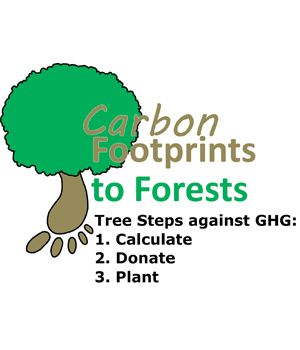Footprints to Forests fights climate change

The wait is over. The website is here: footprintstoforests.com. The website gives people a new and local way to compensate for their personal carbon footprint.
Your carbon footprint represents the greenhouse gas emissions released by typical aspects of your day-to-day life, such as use of a car or truck or other vehicle, energy to heat and run your home, and air travel (if you travel by air). Trees help to capture carbon dioxide and other greenhouse gases. This reduces the impacts of climate change on the planet and in your local area. Trees also provide other benefits such as habitat for diverse species and improved water quality.
The site includes an easy-to-use carbon calculator. You can use the calculator to find out how many tonnes of greenhouse gases are produced by your activities. The calculator also tells you how much it would cost to compensate for the impacts of your vehicle use, home energy use, and air travel. In addition, the site provides information on how many trees will be planted locally with the help of your donation.
The Maitland Valley and Ausable Bayfield conservation authorities launched the new website, which is the key action of the Carbon Footprints to Forests program, created with the financial support of the County of Huron.
Carbon dioxide and other greenhouse gases push average temperatures up but trees can help to reduce the impacts of climate change and help us adapt to the changes we are experiencing in weather and climate. People can support the planting of trees through the new website. This will help the local area adapt to our changing climate and weather extremes, according to the partners in this project.
“As trees grow, they remove carbon dioxide from the atmosphere,†said Kate Monk, Ausable Bayfield Conservation’s Stewardship, Land and Education Manager. “Trees also provide shade and cooling effects when it’s hot, and limit the impact of snow and wind during the wintertime. That helps us adapt to extreme weather events in a changing climate.â€
Compensating for your carbon footprint is easy. First, use the quick and easy calculator at footprintstoforests.com to find out your carbon footprint. Then, make a donation for all or part of your footprint cost. Your local conservation authority will then put that money to work by planting trees. This will help your local area to mitigate greenhouse gases and adapt to changes in weather and climate.
“We think people will find it interesting to figure out how much greenhouse gas is released from their daily activities like driving a car or heating a home,†Monk said. “It is also interesting to know how many trees it takes to compensate for that carbon footprint.â€
Some people may be able to donate the entire cost of their carbon footprint, Monk said, but some people may only be able to donate to compensate for part of it. “If you are able to donate all of your carbon footprint, that’s great, but we are thankful for all donations, large or small,†she said. “Every tree counts.†You may not be in a position to donate at this time but the partners behind the new website invite you to visit the website anyway to find out more about the greenhouse gas emissions that come from home energy use and travel by vehicles or planes.
